
Perform test of hypotheses that gender and admission are independent for each department at the level of significance of
Prove that the only department for which this hypothesis is rejected is department A.
Also prove that the admission rate for women in department A is significantly higher than the rate for men.
Answer to Problem 4CS
There is enough evidence to conclude that the gender and admission are not independent of gender in department A.
There is not enough evidence to conclude that the gender and admission are not independent of gender in department B.
There is not enough evidence to conclude that the gender and admission are not independent of gender in department C.
There is not enough evidence to conclude that the gender and admission are not independent of gender in department D.
There is not enough evidence to conclude that the gender and admission are not independent of gender in department E.
There is not enough evidence to conclude that the gender and admission are not independent of gender in department F.
Explanation of Solution
Calculation:
The six contingency tables with 2 rows and 2 columns for each of the six departments are given. The two rows consist of gender and the two columns consist of accepted and rejected applicants.
A contingency table is obtained as using two qualitative variables. One of the qualitative variable is row variable that has one category for each row of the table another is column variable has one category for each column of the table.
Step 1:
For Department A:
The hypotheses are:
Null Hypothesis:
Alternate Hypothesis:
Step 2:
Now, it is obtained that,
| Gender | Accept | Reject | Row Total |
| Male | 512 | 313 | 825 |
| Female | 89 | 19 | 108 |
| Column Total | 601 | 332 | 933 |
Step 3:
Expected frequencies:
The expected frequencies in case of contingency table is obtained as,
Now, using the formula of expected frequency it is found that the expected frequency for the accepted male is obtained as,
Hence, in similar way the expected frequencies are obtained as,
| Gender | Accept | Reject |
| Male | ||
| Female |
The accept and reject can be rewritten as,
| Accept | 1 |
| Reject | 2 |
Step 4:
Level of significance:
The level of significance is given as 0.01.
Test Statistic:
Software procedure:
Step -by-step software procedure to obtain test statistic using MINITAB software is as follows:
- Select Stat > Table > Cross Tabulation and Chi-Square.
- Check the box of Raw data (categorical variables).
- Under For rows enter Gender.
- Under For columns enter Column.
- Check the box of Count under Display.
- Under Chi-Square, click the box of Chi-Square test.
- Select OK.
- Output using MINITAB software is given below:
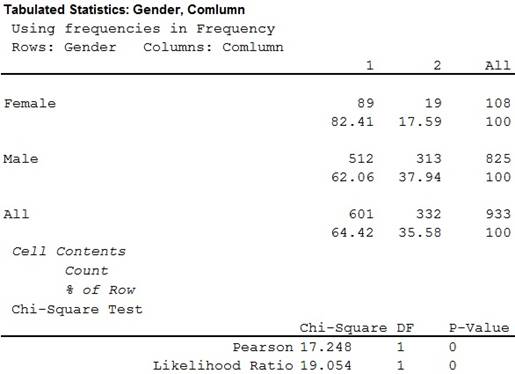
Thus, the value of chi-square statistic is 17.248.
It is known that under the null hypothesis
In the given question there are 2 rows and 2 columns.
Hence, the degrees of freedom is
Thus, the degrees of freedom is 1.
It is known that when the null hypothesis
It is found that all the expected frequencies corresponding to all rows and columns of the given contingency table are more than 5.
Hence, the test of independence is appropriate.
Step 5:
Critical value:
In a test of hypotheses the critical value is the point by which one can reject or accept the null hypothesis.
Software procedure:
Step-by-step software procedure to obtain critical value using MINITAB software is as follows:
- Select Graph > Probability distribution plot > view probability
- Select Chi -Square under distribution.
- In Degrees of freedom, enter 1.
- Choose Probability Value and Right Tail for the region of the curve to shade.
- Enter the Probability value as 0.01 under shaded area.
- Select OK.
- Output using MINITAB software is given below:
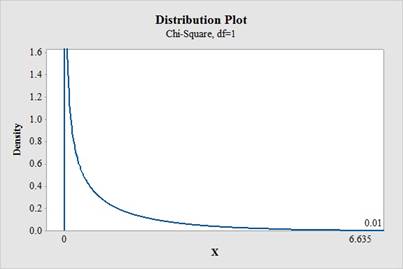
Hence, the critical value at
Rejection rule:
If the
Step 6:
Conclusion:
Here, the
That is,
Thus, the decision is “reject the null hypothesis”.
Thus, there is enough evidence to conclude that the gender and admission are not independent of gender in department A.
For Department B:
Step 1:
The hypotheses are:
The hypotheses are:
Null Hypothesis:
Alternate Hypothesis:
Step 2:
Now, it is obtained that,
| Gender | Accept | Reject | Row Total |
| Male | 353 | 207 | 560 |
| Female | 17 | 8 | 25 |
| Column Total | 370 | 215 | 585 |
Step 3:
Now, using the formula of expected frequency it is found that the expected frequency for the accepted male is obtained as,
Hence, in similar way the expected frequencies are obtained as,
| Gender | Accept | Reject |
| Male | ||
| Female |
The accept and reject can be rewritten as,
| Accept | 1 |
| Reject | 2 |
Step 4:
Level of significance:
The level of significance is given as 0.01.
Test Statistic:
Software procedure:
Step -by-step software procedure to obtain test statistic using MINITAB software is as follows:
- Select Stat > Table > Cross Tabulation and Chi-Square.
- Check the box of Raw data (categorical variables).
- Under For rows enter Gender.
- Under For columns enter Column.
- Check the box of Count under Display.
- Under Chi-Square, click the box of Chi-Square test.
- Select OK.
- Output using MINITAB software is given below:
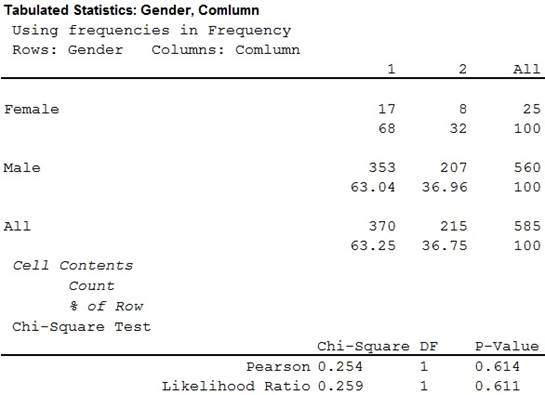
Thus, the value of chi-square statistic is 0.254.
In the given question there are 2 rows and 2 columns.
Hence, the degrees of freedom is
Thus, the degrees of freedom is 1.
It is known that when the null hypothesis
It is found that all the expected frequencies corresponding to all rows and columns of the given contingency table are more than 5.
Hence, the test of independence is appropriate.
Step 5:
Critical value:
In a test of hypotheses the critical value is the point by which one can reject or accept the null hypothesis.
It is already found that the critical value at
Rejection rule:
If the
Step 6:
Conclusion:
Here, the
That is,
Thus, the decision is “fail to reject the null hypothesis”.
Thus, there is not enough evidence to conclude that the gender and admission are not independent of gender in department B.
For Department C:
Step 1:
The hypotheses are:
Null Hypothesis:
Alternate Hypothesis:
Step 2:
Now, it is obtained that,
| Gender | Accept | Reject | Row Total |
| Male | 120 | 205 | 325 |
| Female | 202 | 391 | 593 |
| Column Total | 322 | 596 | 918 |
Step 3:
Now, using the formula of expected frequency it is found that the expected frequency for the accepted male is obtained as,
Hence, in similar way the expected frequencies are obtained as,
| Gender | Accept | Reject |
| Male | ||
| Female |
The accept and reject can be rewritten as,
| Accept | 1 |
| Reject | 2 |
Step 4:
Level of significance:
The level of significance is given as 0.01.
Test Statistic:
Software procedure:
Step -by-step software procedure to obtain test statistic using MINITAB software is as follows:
- Select Stat > Table > Cross Tabulation and Chi-Square.
- Check the box of Raw data (categorical variables).
- Under For rows enter Gender.
- Under For columns enter Column.
- Check the box of Count under Display.
- Under Chi-Square, click the box of Chi-Square test.
- Select OK.
- Output using MINITAB software is given below:
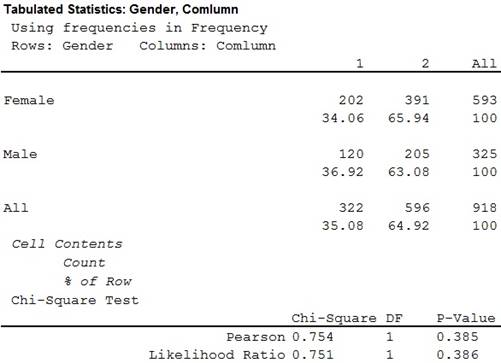
Thus, the value of chi-square statistic is 0.754.
In the given question there are 2 rows and 2 columns.
Hence, the degrees of freedom is
Thus, the degrees of freedom is 1.
It is known that when the null hypothesis
It is found that all the expected frequencies corresponding to all rows and columns of the given contingency table are more than 5.
Hence, the test of independence is appropriate.
Step 5:
Critical value:
In a test of hypotheses the critical value is the point by which one can reject or accept the null hypothesis.
It is already found that the critical value at
Rejection rule:
If the
Step 6:
Conclusion:
Here, the
That is,
Thus, the decision is “fail to reject the null hypothesis”.
Thus, there is not enough evidence to conclude that the gender and admission are not independent of gender in department C.
For Department D:
Step 1:
The hypotheses are:
Null Hypothesis:
Alternate Hypothesis:
Step 2:
Now, it is obtained that,
| Gender | Accept | Reject | Row Total |
| Male | 138 | 279 | 417 |
| Female | 131 | 244 | 375 |
| Column Total | 269 | 523 | 792 |
Step 3:
Now, using the formula of expected frequency it is found that the expected frequency for the accepted male is obtained as,
Hence, in similar way the expected frequencies are obtained as,
| Gender | Accept | Reject |
| Male | ||
| Female |
The accept and reject can be rewritten as,
| Accept | 1 |
| Reject | 2 |
Step 4:
Level of significance:
The level of significance is given as 0.01.
Test Statistic:
Software procedure:
Step -by-step software procedure to obtain test statistic using MINITAB software is as follows:
- Select Stat > Table > Cross Tabulation and Chi-Square.
- Check the box of Raw data (categorical variables).
- Under For rows enter Gender.
- Under For columns enter Column.
- Check the box of Count under Display.
- Under Chi-Square, click the box of Chi-Square test.
- Select OK.
- Output using MINITAB software is given below:
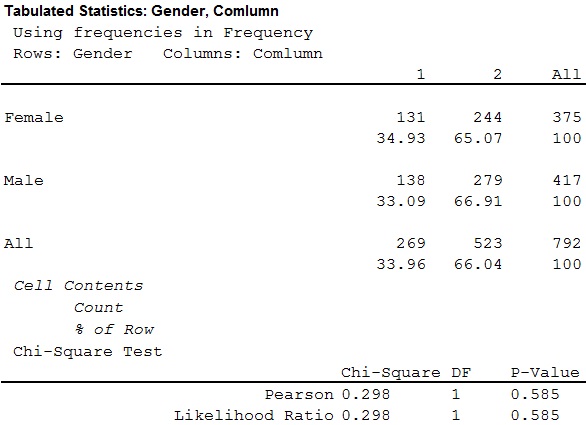
Thus, the value of chi-square statistic is 0.298.
In the given question there are 2 rows and 2 columns.
Hence, the degrees of freedom is
Thus, the degrees of freedom is 1.
It is known that when the null hypothesis
It is found that all the expected frequencies corresponding to all rows and columns of the given contingency table are more than 5.
Hence, the test of independence is appropriate.
Step 5:
Critical value:
In a test of hypotheses the critical value is the point by which one can reject or accept the null hypothesis.
It is already found that the critical value at
Rejection rule:
If the
Step 6:
Conclusion:
Here, the
That is,
Thus, the decision is “fail to reject the null hypothesis”.
Thus, there is not enough evidence to conclude that the gender and admission are not independent of gender in department D.
For Department E:
Step 1:
The hypotheses are:
Null Hypothesis:
Alternate Hypothesis:
Step 2:
Now, it is obtained that,
| Gender | Accept | Reject | Row Total |
| Male | 53 | 138 | 191 |
| Female | 94 | 299 | 383 |
| Column Total | 147 | 437 | 584 |
Step 3:
Now, using the formula of expected frequency it is found that the expected frequency for the accepted male is obtained as,
Hence, in similar way the expected frequencies are obtained as,
| Gender | Accept | Reject |
| Male | ||
| Female |
Step 4:
Level of significance:
The level of significance is given as 0.01.
Test Statistic:
Software procedure:
Step -by-step software procedure to obtain test statistic using MINITAB software is as follows:
- Select Stat > Table > Cross Tabulation and Chi-Square.
- Check the box of Raw data (categorical variables).
- Under For rows enter Gender.
- Under For columns enter Column.
- Check the box of Count under Display.
- Under Chi-Square, click the box of Chi-Square test.
- Select OK.
- Output using MINITAB software is given below:

Thus, the value of chi-square statistic is 1.001.
In the given question there are 2 rows and 2 columns.
Hence, the degrees of freedom is
Thus, the degrees of freedom is 1.
It is known that when the null hypothesis
It is found that all the expected frequencies corresponding to all rows and columns of the given contingency table are more than 5.
Hence, the test of independence is appropriate.
Step 5:
Critical value:
In a test of hypotheses the critical value is the point by which one can reject or accept the null hypothesis.
It is already found that the critical value at
Rejection rule:
If the
Step 6:
Conclusion:
Here, the
That is,
Thus, the decision is “fail to reject the null hypothesis”.
Thus, there is not enough evidence to conclude that the gender and admission are not independent of gender in department E.
For Department F:
Step 1:
The hypotheses are:
Null Hypothesis:
Alternate Hypothesis:
Step 2:
Now, it is obtained that,
| Gender | Accept | Reject | Row Total |
| Male | 22 | 351 | 373 |
| Female | 24 | 317 | 341 |
| Column Total | 46 | 668 | 714 |
Step 3:
Now, using the formula of expected frequency it is found that the expected frequency for the accepted male is obtained as,
Hence, in similar way the expected frequencies are obtained as,
| Gender | Accept | Reject |
| Male | ||
| Female |
The accept and reject can be rewritten as,
| Accept | 1 |
| Reject | 2 |
Step 4:
Level of significance:
The level of significance is given as 0.01.
Test Statistic:
Software procedure:
Step -by-step software procedure to obtain test statistic using MINITAB software is as follows:
- Select Stat > Table > Cross Tabulation and Chi-Square.
- Check the box of Raw data (categorical variables).
- Under For rows enter Gender.
- Under For columns enter Column.
- Check the box of Count under Display.
- Under Chi-Square, click the box of Chi-Square test.
- Select OK.
- Output using MINITAB software is given below:
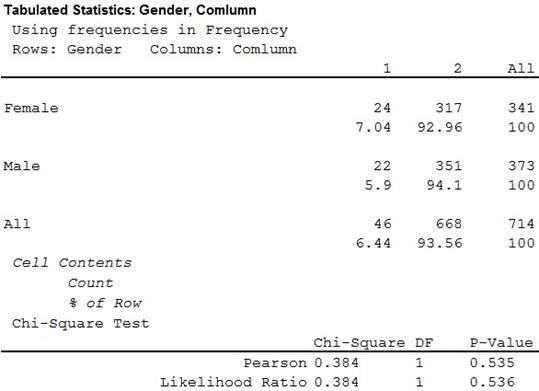
Thus, the value of chi-square statistic is 0.384.
In the given question there are 2 rows and 2 columns.
Hence, the degrees of freedom is
Thus, the degrees of freedom is 1.
It is known that when the null hypothesis
It is found that all the expected frequencies corresponding to all rows and columns of the given contingency table are more than 5.
Hence, the test of independence is appropriate.
Step 5:
Critical value:
In a test of hypotheses the critical value is the point by which one can reject or accept the null hypothesis.
It is already found that the critical value at
Rejection rule:
If the
Step 6:
Conclusion:
Here, the
That is,
Thus, the decision is “fail to reject the null hypothesis”.
Thus, there is not enough evidence to conclude that the gender and admission are not independent of gender in department F.
Thus, it is clear that the only department for which this hypothesis is rejected is department A.
The accepted number of women out of total 108 women is 89.
Hence, the percentage of accepted number of women in department A is,
The accepted number of men out of total 825 men is 512.
Hence, the accepted number of men in department A is,
Thus, it can be concluded that the admission rate for women in department A is significantly higher than the rate for men.
Want to see more full solutions like this?
Chapter 10 Solutions
Essential Statistics
- You have been hired as an intern to run analyses on the data and report the results back to Sarah; the five questions that Sarah needs you to address are given below. please do it step by step on excel Does there appear to be a positive or negative relationship between price and screen size? Use a scatter plot to examine the relationship. Determine and interpret the correlation coefficient between the two variables. In your interpretation, discuss the direction of the relationship (positive, negative, or zero relationship). Also discuss the strength of the relationship. Estimate the relationship between screen size and price using a simple linear regression model and interpret the estimated coefficients. (In your interpretation, tell the dollar amount by which price will change for each unit of increase in screen size). Include the manufacturer dummy variable (Samsung=1, 0 otherwise) and estimate the relationship between screen size, price and manufacturer dummy as a multiple…arrow_forwardHere is data with as the response variable. x y54.4 19.124.9 99.334.5 9.476.6 0.359.4 4.554.4 0.139.2 56.354 15.773.8 9-156.1 319.2Make a scatter plot of this data. Which point is an outlier? Enter as an ordered pair, e.g., (x,y). (x,y)= Find the regression equation for the data set without the outlier. Enter the equation of the form mx+b rounded to three decimal places. y_wo= Find the regression equation for the data set with the outlier. Enter the equation of the form mx+b rounded to three decimal places. y_w=arrow_forwardYou have been hired as an intern to run analyses on the data and report the results back to Sarah; the five questions that Sarah needs you to address are given below. please do it step by step Does there appear to be a positive or negative relationship between price and screen size? Use a scatter plot to examine the relationship. Determine and interpret the correlation coefficient between the two variables. In your interpretation, discuss the direction of the relationship (positive, negative, or zero relationship). Also discuss the strength of the relationship. Estimate the relationship between screen size and price using a simple linear regression model and interpret the estimated coefficients. (In your interpretation, tell the dollar amount by which price will change for each unit of increase in screen size). Include the manufacturer dummy variable (Samsung=1, 0 otherwise) and estimate the relationship between screen size, price and manufacturer dummy as a multiple linear…arrow_forward
- Exercises: Find all the whole number solutions of the congruence equation. 1. 3x 8 mod 11 2. 2x+3= 8 mod 12 3. 3x+12= 7 mod 10 4. 4x+6= 5 mod 8 5. 5x+3= 8 mod 12arrow_forwardScenario Sales of products by color follow a peculiar, but predictable, pattern that determines how many units will sell in any given year. This pattern is shown below Product Color 1995 1996 1997 Red 28 42 21 1998 23 1999 29 2000 2001 2002 Unit Sales 2003 2004 15 8 4 2 1 2005 2006 discontinued Green 26 39 20 22 28 14 7 4 2 White 43 65 33 36 45 23 12 Brown 58 87 44 48 60 Yellow 37 56 28 31 Black 28 42 21 Orange 19 29 Purple Total 28 42 21 49 68 78 95 123 176 181 164 127 24 179 Questions A) Which color will sell the most units in 2007? B) Which color will sell the most units combined in the 2007 to 2009 period? Please show all your analysis, leave formulas in cells, and specify any assumptions you make.arrow_forwardOne hundred students were surveyed about their preference between dogs and cats. The following two-way table displays data for the sample of students who responded to the survey. Preference Male Female TOTAL Prefers dogs \[36\] \[20\] \[56\] Prefers cats \[10\] \[26\] \[36\] No preference \[2\] \[6\] \[8\] TOTAL \[48\] \[52\] \[100\] problem 1 Find the probability that a randomly selected student prefers dogs.Enter your answer as a fraction or decimal. \[P\left(\text{prefers dogs}\right)=\] Incorrect Check Hide explanation Preference Male Female TOTAL Prefers dogs \[\blueD{36}\] \[\blueD{20}\] \[\blueE{56}\] Prefers cats \[10\] \[26\] \[36\] No preference \[2\] \[6\] \[8\] TOTAL \[48\] \[52\] \[100\] There were \[\blueE{56}\] students in the sample who preferred dogs out of \[100\] total students.arrow_forward
- Business discussarrow_forwardYou have been hired as an intern to run analyses on the data and report the results back to Sarah; the five questions that Sarah needs you to address are given below. Does there appear to be a positive or negative relationship between price and screen size? Use a scatter plot to examine the relationship. Determine and interpret the correlation coefficient between the two variables. In your interpretation, discuss the direction of the relationship (positive, negative, or zero relationship). Also discuss the strength of the relationship. Estimate the relationship between screen size and price using a simple linear regression model and interpret the estimated coefficients. (In your interpretation, tell the dollar amount by which price will change for each unit of increase in screen size). Include the manufacturer dummy variable (Samsung=1, 0 otherwise) and estimate the relationship between screen size, price and manufacturer dummy as a multiple linear regression model. Interpret the…arrow_forwardDoes there appear to be a positive or negative relationship between price and screen size? Use a scatter plot to examine the relationship. How to take snapshots: if you use a MacBook, press Command+ Shift+4 to take snapshots. If you are using Windows, use the Snipping Tool to take snapshots. Question 1: Determine and interpret the correlation coefficient between the two variables. In your interpretation, discuss the direction of the relationship (positive, negative, or zero relationship). Also discuss the strength of the relationship. Value of correlation coefficient: Direction of the relationship (positive, negative, or zero relationship): Strength of the relationship (strong/moderate/weak): Question 2: Estimate the relationship between screen size and price using a simple linear regression model and interpret the estimated coefficients. In your interpretation, tell the dollar amount by which price will change for each unit of increase in screen size. (The answer for the…arrow_forward
- In this problem, we consider a Brownian motion (W+) t≥0. We consider a stock model (St)t>0 given (under the measure P) by d.St 0.03 St dt + 0.2 St dwt, with So 2. We assume that the interest rate is r = 0.06. The purpose of this problem is to price an option on this stock (which we name cubic put). This option is European-type, with maturity 3 months (i.e. T = 0.25 years), and payoff given by F = (8-5)+ (a) Write the Stochastic Differential Equation satisfied by (St) under the risk-neutral measure Q. (You don't need to prove it, simply give the answer.) (b) Give the price of a regular European put on (St) with maturity 3 months and strike K = 2. (c) Let X = S. Find the Stochastic Differential Equation satisfied by the process (Xt) under the measure Q. (d) Find an explicit expression for X₁ = S3 under measure Q. (e) Using the results above, find the price of the cubic put option mentioned above. (f) Is the price in (e) the same as in question (b)? (Explain why.)arrow_forwardProblem 4. Margrabe formula and the Greeks (20 pts) In the homework, we determined the Margrabe formula for the price of an option allowing you to swap an x-stock for a y-stock at time T. For stocks with initial values xo, yo, common volatility σ and correlation p, the formula was given by Fo=yo (d+)-x0Þ(d_), where In (±² Ꭲ d+ õ√T and σ = σ√√√2(1 - p). дго (a) We want to determine a "Greek" for ỡ on the option: find a formula for θα (b) Is дго θα positive or negative? (c) We consider a situation in which the correlation p between the two stocks increases: what can you say about the price Fo? (d) Assume that yo< xo and p = 1. What is the price of the option?arrow_forwardWe consider a 4-dimensional stock price model given (under P) by dẴ₁ = µ· Xt dt + йt · ΣdŴt where (W) is an n-dimensional Brownian motion, π = (0.02, 0.01, -0.02, 0.05), 0.2 0 0 0 0.3 0.4 0 0 Σ= -0.1 -4a За 0 0.2 0.4 -0.1 0.2) and a E R. We assume that ☑0 = (1, 1, 1, 1) and that the interest rate on the market is r = 0.02. (a) Give a condition on a that would make stock #3 be the one with largest volatility. (b) Find the diversification coefficient for this portfolio as a function of a. (c) Determine the maximum diversification coefficient d that you could reach by varying the value of a? 2arrow_forward
 MATLAB: An Introduction with ApplicationsStatisticsISBN:9781119256830Author:Amos GilatPublisher:John Wiley & Sons Inc
MATLAB: An Introduction with ApplicationsStatisticsISBN:9781119256830Author:Amos GilatPublisher:John Wiley & Sons Inc Probability and Statistics for Engineering and th...StatisticsISBN:9781305251809Author:Jay L. DevorePublisher:Cengage Learning
Probability and Statistics for Engineering and th...StatisticsISBN:9781305251809Author:Jay L. DevorePublisher:Cengage Learning Statistics for The Behavioral Sciences (MindTap C...StatisticsISBN:9781305504912Author:Frederick J Gravetter, Larry B. WallnauPublisher:Cengage Learning
Statistics for The Behavioral Sciences (MindTap C...StatisticsISBN:9781305504912Author:Frederick J Gravetter, Larry B. WallnauPublisher:Cengage Learning Elementary Statistics: Picturing the World (7th E...StatisticsISBN:9780134683416Author:Ron Larson, Betsy FarberPublisher:PEARSON
Elementary Statistics: Picturing the World (7th E...StatisticsISBN:9780134683416Author:Ron Larson, Betsy FarberPublisher:PEARSON The Basic Practice of StatisticsStatisticsISBN:9781319042578Author:David S. Moore, William I. Notz, Michael A. FlignerPublisher:W. H. Freeman
The Basic Practice of StatisticsStatisticsISBN:9781319042578Author:David S. Moore, William I. Notz, Michael A. FlignerPublisher:W. H. Freeman Introduction to the Practice of StatisticsStatisticsISBN:9781319013387Author:David S. Moore, George P. McCabe, Bruce A. CraigPublisher:W. H. Freeman
Introduction to the Practice of StatisticsStatisticsISBN:9781319013387Author:David S. Moore, George P. McCabe, Bruce A. CraigPublisher:W. H. Freeman





